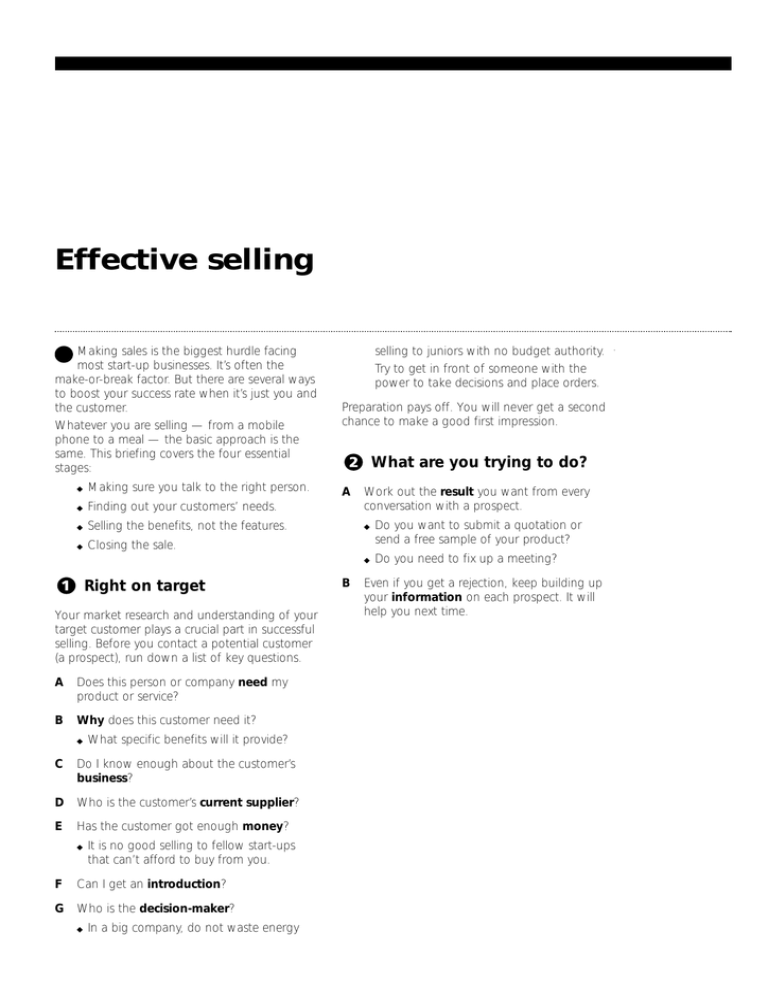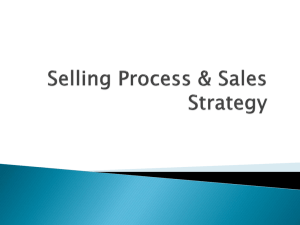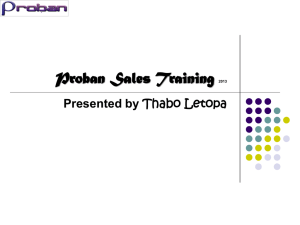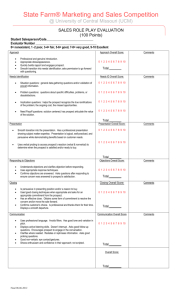Effective selling
advertisement

Effective selling Making sales is the biggest hurdle facing most start-up businesses. It’s often the make-or-break factor. But there are several ways to boost your success rate when it’s just you and the customer. Whatever you are selling — from a mobile phone to a meal — the basic approach is the same. This briefing covers the four essential stages: ◆ Making sure you talk to the right person. ◆ Finding out your customers’ needs. ◆ Selling the benefits, not the features. ◆ Closing the sale. Right on target Your market research and understanding of your target customer plays a crucial part in successful selling. Before you contact a potential customer (a prospect), run down a list of key questions. A Does this person or company need my product or service? B Why does this customer need it? ◆ C What specific benefits will it provide? Do I know enough about the customer’s business? D Who is the customer’s current supplier? E Has the customer got enough money? ◆ F It is no good selling to fellow start-ups that can’t afford to buy from you. Can I get an introduction? G Who is the decision-maker? ◆ In a big company, do not waste energy selling to juniors with no budget authority. Try to get in front of someone with the power to take decisions and place orders. Preparation pays off. You will never get a second chance to make a good first impression. What are you trying to do? A Work out the result you want from every conversation with a prospect. B ◆ Do you want to submit a quotation or send a free sample of your product? ◆ Do you need to fix up a meeting? Even if you get a rejection, keep building up your information on each prospect. It will help you next time. Reach the decision-maker B Be open and honest. Explain who you are. ◆ It’s likely you won’t be able to speak to a decision-maker immediately, as many employees are instructed to protect the boss from unsolicited sales calls. But if you treat your initial contact correctly, you can raise your chances of speaking with the right person. A Greet the initial person. ◆ Try to get their name early on, as this will help you next time you call. C Just sounding polite and cheerful will get you a long way. Show knowledge of the company, eg ‘I would like to discuss the garden sheds your company sells’. D Show a benefit, eg ‘I think Mr X will want to speak with me because we have a shelving product that sells well alongside your sheds’. ◆ Ideally, make the contact worry that turning you away now may mean missing an opportunity for the company. Getting the appointment E Phoning to fix an appointment need not be daunting if you take a systematic approach. Ask for help, eg “I am trying to get an appointment with Mr X. Can you help me?” F Ask for an appointment at a definite time. A Check you are speaking to the right person, introduce yourself and establish a basis for talking as soon as you can. B ◆ ‘Did you receive my letter?’ ◆ ‘Your friend X suggested I call you.’ ◆ ‘Did you see the article about our company in Y magazine?’ Provide a persuasive reason for meeting and try to confirm a time and date. ◆ ◆ C Pick one key benefit and tailor the way you present it to suit the customer’s immediate needs. Start by suggesting a date that suits you, and let the customer come back with an alternative if this is not convenient. Aim to keep the conversation moving forward. Here are some routine brushoffs, and how you might respond. ◆ ‘Let me think about it.’ ‘Of course. What is it that particularly concerns you?’ ◆ ‘Put something in the post to me and I’ll look at it.’ ‘OK. Which type of product are you particularly interested in?’ ◆ ‘I have to go into a meeting now.’ ‘Fine. I’ll send you a letter following up on our discussion.’ D If you get an outright brush-off, do not take it personally. Try to pin down the reason why the prospect is not interested. ◆ Is it just that the timing is wrong? ◆ Should you call back in six months? More appointments mean more sales. Allow time every week to top up the pipeline. G If you are asked to put something in the post, react in a constructive way. ◆ Explain that it would help to talk to the right person first, so you can send tailored information and not just a standard pack. Creating interest A When you open a sale, establish right away that you are not wasting the prospect’s time. ◆ B Make it clear you believe there are genuine benefits for the customer. It helps to start by asking a series of questions which can only be answered ‘Yes’. This creates a positive momentum and helps you involve the prospect while progressing to the next thing you want to say. Compare these examples: ◆ Bad opening: ‘I do injection moulding and I want to tell you about my services.’ Response: ‘I’m sorry, I’m not interested. Goodbye.’ Good opening: ‘I have a small injection moulding shop and I gather you use plastic mouldings. Is that correct?’ Response: ‘Yes, we do.’ ◆ Bad opening: ‘I am calling to see if you need any printing done.’ Response: ‘No thanks, we don’t. Goodbye.’ Good opening: ‘I am calling about your printing. I believe you send out a catalogue every year. Is that right?’ Response: ‘Yes, we do.’ page 2 to merit taking action. Follow up with: ‘Good, because we specialise in high-quality catalogue work...’ ◆ Do they need your product? Compare these two statements, with two different approaches to selling: Salesman 1: ‘This PC has lots of RAM. I recommend it.’ Salesman 2: ‘This PC has enough memory for you to handle word processing and the management accounts. It’s just what you need.’ Salesman 1 is selling the product. His sales pitch will be the same for every customer he talks to. Salesman 2 has found out the prospect’s needs, so he can then sell the benefits of his product. He will sell many more PCs than Salesman 1. Emphasise the benefits Once you know what the prospect is looking for, you can offer the solution — your product. If a prospect is interested but undecided, remove any remaining doubts by explaining why your product is ideal. A Sell the benefits, not the features. Or, as the marketing saying goes, ‘Sell the sizzle, not the steak.’ A Use open questions (questions that cannot be answered ‘Yes’ or ‘No’) when investigating potential customers’ needs. ◆ B ‘Why do you buy them from Germany?’ ◆ ‘What are you looking for when you buy this type of shelving?’ ◆ Feature: Duck-down in a sleeping bag. Benefit: ‘This sleeping bag will keep you warmer.’ ◆ Feature: Teflon coating on saucepan. Benefit: ‘To wash it up, just wipe it.’ ◆ Feature: High-speed printer mechanism. Benefit: ‘It will give you improved productivity in the office.’ ◆ Feature: Good design for a shop sign. Benefit: ‘It will bring in more of the kind of customers you want.’ Listen carefully to what the prospect says. ◆ C ‘What garden accessories do you currently sell?’ ◆ Top sales people talk little and listen a lot. A feature is an attribute of the product or service, such as size, design or simply what it achieves. Make sure your prospects understand their own needs and opportunities. ◆ A benefit is what the feature can do for the customer. But it is only relevant if it is something that particular customer wants. ‘So when your customers buy sheds, they don’t buy shelves for them. If they did, what would the extra sales be worth?’ D Confirm that the need is important enough B Match benefits to the prospect’s needs. ◆ The three types of benefit A Standard benefits are provided by both you and your competitors. ◆ B C ◆ E Company benefits are those a customer gains by dealing with your company. F For example, if you offer a loyalty scheme or ‘frequent-user’ discount. Company benefits are useful if you do not offer any differential benefits. ‘Insulating the loft would save you £500 a year. It will pay for itself in three years.’ D Produce evidence to back up your claims. These benefits are the key to success, giving customers a concrete reason to buy from you. ◆ ‘As you hate gardening, I’m sure you will appreciate the paved back garden — no lawn to mow if you buy this house.’ Quantify the benefits. ◆ Differential benefits set your product or service apart from those of your competitors. ◆ C If you only supply standard benefits, try to build some differential ones into your offer. ‘So would you be interested in adding an extra £20,000-worth of sales a year by stocking shelving?’ Photos, cuttings, research reports and testimonials all help to reinforce the point. Mention customers and their comments. ◆ ‘Customers tell me our umbrellas last longer because they are so well-made.’ Be prepared to discuss rival products, but provide proof of the advantages you offer. ◆ ‘Independent studies prove we can give you lower lifetime running costs.’ Make your point strongly, but never rubbish your competitors. page 3 concern: ‘You’re right to ask about quality.’ Objections to the sale You should welcome objections as a sign that the prospect is taking you seriously. When an objection is raised, listen carefully to exactly what is said. You will soon come to recognise the common problem areas: A There is an established relationship with an existing supplier. ◆ B Gently make an opening for yourself. ‘If you have a good supplier, it makes no sense to change. Unless of course, a new one has more to offer. My customers tell me our pricing, quality and service are very competitive. Why not try us out with one small order? You have nothing to lose.’ The customer likes your product, but thinks it is too expensive. ◆ ◆ ◆ Explain that your product is actually good value and demonstrate why. Often a customer whose mind is made up just wants to be reassured the decision is right before giving you the order. B ◆ C Talk about the specific benefits of your product as they relate to the specific needs of this individual customer. Closing the sale It is amazing how often a business person walks away from a prospect, after considerable time and effort, without asking for the sale. A Don’t expect your customer to do the work of closing the sale for you. B C Once you realise the prospect is ready to buy, stop selling. ◆ This can even happen before you have started delivering any sort of sales pitch. ◆ If you do not stop, you may go on to talk yourself out of a sale. Check and confirm what has been agreed. ◆ C Doubts are voiced about quality and whether you can achieve it consistently. ◆ Ask: ‘What are the specifications you would expect us to meet?’ Then briefly explain how your product does meet the specification, your company’s rigorous quality control systems and good reputation, and so on. Probe to see if this is the real objection. Ask: ‘If you did have the money available now, would you buy it?’ ◆ Show how a credit arrangement, payment by instalments or some other financing approach could make the deal possible. ◆ Demonstrate the savings the customer would make — and how quickly they would feed through. Handling objections Isolate and test the objection by asking if the prospect has any other concerns about your product. Then deal with it. A Acknowledge the validity of the prospect’s ‘So, you have chosen the blue one.’ D Close the sale: E D The customer pleads lack of money. ◆ Do not simply re-hash your sales pitch. Do not allow a minor objection to take on an exaggerated importance by spending longer than necessary on it. Sell the full package you offer, including your reliable after-sales service and the fact that there are no hidden costs. Keep stressing the benefits of your product, not its features. Tackle the objection directly and from the customer’s perspective. F ◆ This is best done in an upbeat, positive manner. ◆ The ‘alternatives’ close is also effective, particularly in retailing: ‘Do you prefer the blue one or the red?’ Some people find it hard to close a sale, even when a customer is eager to buy. ◆ The simplest way of all is to ask: ‘Can I take your order now?’ ◆ Once you have asked for the sale, resist the temptation to say any more. Your silence encourages the customer to think things through and reach a decision. When there is just one objection left and you have checked that any others have been answered (see 8), you can use a technique known as the conditional close. ◆ Ask: ‘If I can guarantee to get the delivery date brought forward to meet your schedule, will you place the order now?’ A hesitant buyer can often be won over by this reassurance that the one remaining stumbling block is now an explicit condition of the sale. page 4



